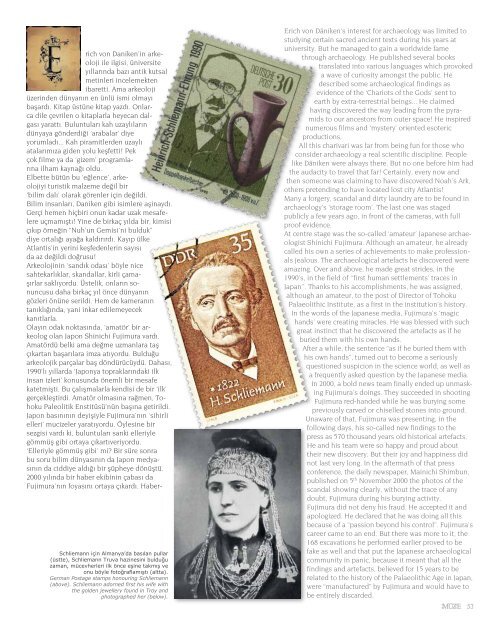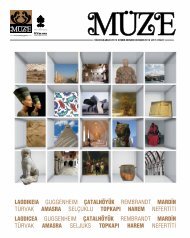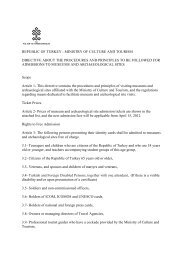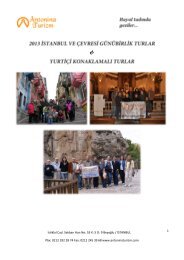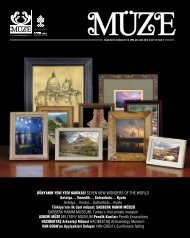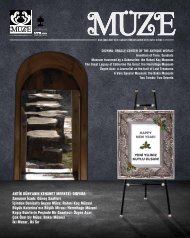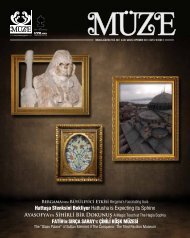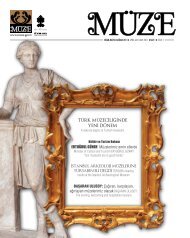GAZİANTEP ZEUGMA MOZAİK MÜZESİ
GAZİANTEP ZEUGMA MOZAİK MÜZESİ
GAZİANTEP ZEUGMA MOZAİK MÜZESİ
You also want an ePaper? Increase the reach of your titles
YUMPU automatically turns print PDFs into web optimized ePapers that Google loves.
ich von Daniken’in arkeoloji<br />
ile ilgisi, üniversite<br />
yıllarında bazı antik kutsal<br />
metinleri incelemekten<br />
ibaretti. Ama arkeoloji<br />
üzerinden dünyanın en ünlü ismi olmayı<br />
başardı. Kitap üstüne kitap yazdı. Onlarca<br />
dile çevrilen o kitaplarla heyecan dalgası<br />
yarattı. Buluntuları kah uzaylıların<br />
dünyaya gönderdiği ‘arabalar’ diye<br />
yorumladı... Kah piramitlerden uzaylı<br />
atalarımıza giden yolu keşfetti! Pek<br />
çok filme ya da ‘gizem’ programlarına<br />
ilham kaynağı oldu.<br />
Elbette bütün bu ‘eğlence’, arkeolojiyi<br />
turistik malzeme değil bir<br />
‘bilim dalı’ olarak görenler için değildi.<br />
Bilim insanları, Daniken gibi isimlere aşinaydı.<br />
Gerçi hemen hiçbiri onun kadar uzak mesafelere<br />
uçmamıştı! Yine de birkaç yılda bir, kimisi<br />
çıkıp örneğin “Nuh’un Gemisi’ni bulduk”<br />
diye ortalığı ayağa kaldırırdı. Kayıp ülke<br />
Atlantis’in yerini keşfedenlerin sayısı<br />
da az değildi doğrusu!<br />
Arkeolojinin ‘sandık odası’ böyle nice<br />
sahtekarlıklar, skandallar, kirli çamaşırlar<br />
saklıyordu. Üstelik, onların sonuncusu<br />
daha birkaç yıl önce dünyanın<br />
gözleri önüne serildi. Hem de kameranın<br />
tanıklığında, yani inkar edilemeyecek<br />
kanıtlarla.<br />
Olayın odak noktasında, ‘amatör’ bir arkeolog<br />
olan Japon Shinichi Fujimura vardı.<br />
Amatördü belki ama değme uzmanlara taş<br />
çıkartan başarılara imza atıyordu. Bulduğu<br />
arkeolojik parçalar baş döndürücüydü. Dahası,<br />
1990’lı yıllarda ‘Japonya topraklarındaki ilk<br />
insan izleri’ konusunda önemli bir mesafe<br />
katetmişti. Bu çalışmalarla kendisi de bir ‘ilk’<br />
gerçekleştirdi. Amatör olmasına rağmen, Tohoku<br />
Paleolitik Enstitüsü’nün başına getirildi.<br />
Japon basınının deyişiyle Fujimura’nın ‘sihirli<br />
elleri’ mucizeler yaratıyordu. Öylesine bir<br />
sezgisi vardı ki, buluntuları sanki elleriyle<br />
gömmüş gibi ortaya çıkartıveriyordu.<br />
‘Elleriyle gömmüş gibi’ mi? Bir süre sonra<br />
bu soru bilim dünyasının da Japon medyasının<br />
da ciddiye aldığı bir şüpheye dönüştü.<br />
2000 yılında bir haber ekibinin çabası da<br />
Fujimura’nın foyasını ortaya çıkardı. Haber-<br />
Schliemann için Almanya’da basılan pullar<br />
(üstte), Schliemann Truva hazinesini bulduğu<br />
zaman, mücevherleri ilk önce eşine takmış ve<br />
onu böyle fotoğraflamıştı (altta).<br />
German Postage stamps honouring Schliemann<br />
(above). Schliemann adorned first his wife with<br />
the golden jewellery found in Troy and<br />
photographed her (below).<br />
Erich von Däniken’s interest for archaeology was limited to<br />
studying certain sacred ancient texts during his years at<br />
university. But he managed to gain a worldwide fame<br />
through archaeology. He published several books<br />
translated into various languages which provoked<br />
a wave of curiosity amongst the public. He<br />
described some archaeological findings as<br />
evidence of the ‘Chariots of the Gods’ sent to<br />
earth by extra-terrestrial beings... He claimed<br />
having discovered the way leading from the pyramids<br />
to our ancestors from outer space! He inspired<br />
numerous films and ‘mystery’ oriented esoteric<br />
productions.<br />
All this charivari was far from being fun for those who<br />
consider archaeology a real scientific discipline. People<br />
like Däniken were always there. But no one before him had<br />
the audacity to travel that far! Certainly, every now and<br />
then someone was claiming to have discovered Noah’s Ark,<br />
others pretending to have located lost city Atlantis!<br />
Many a forgery, scandal and dirty laundry are to be found in<br />
archaeology’s ‘storage room’. The last one was staged<br />
publicly a few years ago, in front of the cameras, with full<br />
proof evidence.<br />
At centre stage was the so-called ‘amateur’ Japanese archaeologist<br />
Shinichi Fujimura. Although an amateur, he already<br />
called his own a series of achievements to make professionals<br />
jealous. The archaeological artefacts he discovered were<br />
amazing. Over and above, he made great strides, in the<br />
1990’s, in the field of ‘‘first human settlements’ traces in<br />
Japan’’. Thanks to his accomplishments, he was assigned,<br />
although an amateur, to the post of Director of Tohoku<br />
Palaeolithic Institute, as a first in the institution’s history.<br />
In the words of the Japanese media, Fujimura’s ‘magic<br />
hands’ were creating miracles. He was blessed with such<br />
great instinct that he discovered the artefacts as if he<br />
buried them with his own hands.<br />
After a while, the sentence “as if he buried them with<br />
his own hands”, turned out to become a seriously<br />
questioned suspicion in the science world, as well as<br />
a frequently asked question by the Japanese media.<br />
In 2000, a bold news team finally ended up unmasking<br />
Fujimura’s doings. They succeeded in shooting<br />
Fujimura red-handed while he was burying some<br />
previously carved or chiselled stones into ground.<br />
Unaware of that, Fujimura was presenting, in the<br />
following days, his so-called new findings to the<br />
press as 570 thousand years old historical artefacts.<br />
He and his team were so happy and proud about<br />
their new discovery. But their joy and happiness did<br />
not last very long. In the aftermath of that press<br />
conference, the daily newspaper, Mainichi Shimbun,<br />
published on 5 th November 2000 the photos of the<br />
scandal showing clearly, without the trace of any<br />
doubt, Fujimura during his burying activity.<br />
Fujimura did not deny his fraud. He accepted it and<br />
apologized. He declared that he was doing all this<br />
because of a “passion beyond his control”. Fujimura’s<br />
career came to an end. But there was more to it, the<br />
168 excavations he performed earlier proved to be<br />
fake as well and that put the Japanese archaeological<br />
community in panic, because it meant that all the<br />
findings and artefacts, believed for 15 years to be<br />
related to the history of the Palaeolithic Age in Japan,<br />
were “manufactured” by Fujimura and would have to<br />
be entirely discarded.<br />
53


